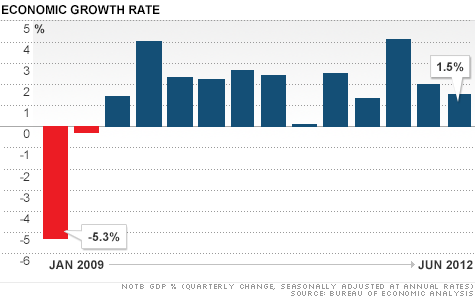Search News

The U.S. economy slowed in the second quarter.
NEW YORK (CNNMoney) -- The United States economy slowed in the second quarter amid weak consumer spending, government cuts and a rise in imports from foreign countries.
Gross domestic product, the broadest measure of the nation's economic health, grew at an annual rate of 1.5% from April to June, the Commerce Department said Friday.
That's down significantly from a 2% rate in the first three months of the year.
The Commerce Department also released revisions going back to the start of 2009. While the revisions showed that growth in 2010 was weaker than previously thought, 2009 and 2011 were slightly stronger.
The second-quarter slowdown was not entirely surprising given consumer spending has been weak recently, the government has been cutting its spending and hiring has been tepid. Economists surveyed by CNNMoney were expecting to see 1.4% growth.
The economy needs to grow around 3% a year to bring the unemployment rate down significantly, and since consumer spending accounts for roughly two-thirds of the economy, it too needs to grow around 3%.
But spending slowed to 1.5%, down from 2.4% in the first quarter, showing that households are continuing to deleverage three years after the recession.
Shoppers cut back on buying big-ticket items like automobiles, as well as smaller items like clothing and groceries.
As usual, the U.S. also imported more goods and services from foreign countries than it exported, which subtracts from economic growth.
Government cuts, especially at the state and local level, also weighed on growth.
Spending by businesses remained a small strength. Businesses increased their purchases of equipment and software to a 7.2% annual rate.
Economists are hopeful the economy will grow slightly faster in the second half of the year. The housing market has recently shown signs of recovering, which could translate into more construction jobs and consumer spending.
But the effect is likely to be slow and hardly any forecasters are predicting GDP growth above 2% any time soon.
"I'm having a hard time seeing where growth drivers would come from," said Chris Jones, economist with TD Bank.
Uncertainty about Europe's debt crisis and the looming fiscal cliff give businesses little incentive to invest or hire new workers. Given the divisive political climate in Washington D.C., it's unlikely the government will agree on measures to boost the economy.
The Federal Reserve could consider further monetary stimulus at its meeting next week, but economists say that's hardly encouraging. Any efforts by the central bank are unlikely to make much difference at this point.
"Interest rates are not the issue.The problem right now isn't the supply of credit, it's the demand for it," Jones said.
What's left? "The weight of the recovery falls on consumers, but they're not able to spend their way to prosperity because they're still focused on deleveraging," he said.
The Commerce Department stressed that the numbers released Friday were based on incomplete data, and it plans to revise the GDP figures twice in the next few months. ![]()
| Overnight Avg Rate | Latest | Change | Last Week |
|---|---|---|---|
| 30 yr fixed | 3.80% | 3.88% | |
| 15 yr fixed | 3.20% | 3.23% | |
| 5/1 ARM | 3.84% | 3.88% | |
| 30 yr refi | 3.82% | 3.93% | |
| 15 yr refi | 3.20% | 3.23% |
Today's featured rates:
| Latest Report | Next Update |
|---|---|
| Home prices | Aug 28 |
| Consumer confidence | Aug 28 |
| GDP | Aug 29 |
| Manufacturing (ISM) | Sept 4 |
| Jobs | Sept 7 |
| Inflation (CPI) | Sept 14 |
| Retail sales | Sept 14 |